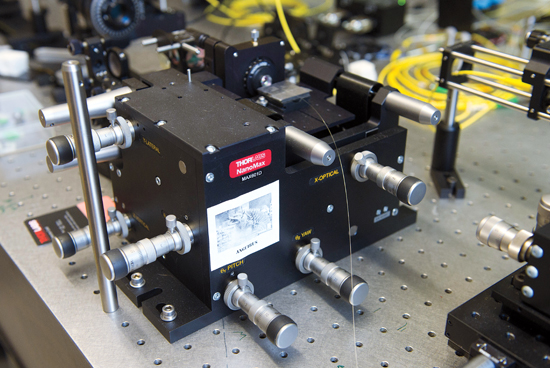If you thought there was no problem with internet bandwidth, consider that on a typical weeknight, Netflix-streamed videos alone consume almost a third of the bandwidth used in North America. And that’s without streaming Game of Thrones, which is available only on discs. Add to that the potential traffic of a half dozen Netflix wannabes and the burgeoning number of data-devouring mobile devices, and it quickly becomes clear that the ability to move more data faster is a requirement of life today, not an option for future generations.
The people who worry about such things (engineers) have been wondering for years about where the next breakthrough will come from. Now, it seems, there’s a good chance that it will come from the College of Engineering, where Siddharth Ramachandran, an associate professor of electrical and computer engineering, has developed a fiber-optic technology that can transmit vastly greater amounts of data at very low cost.
“Our discovery has profound implications for a variety of fields,” says Ramachandran, who was recently named by the IEEE Photonics Society one of six Distinguished Lecturers for the 2013–2014 term, an award that honors researchers who have made outstanding technical, industrial, or entrepreneurial contributions to the field of lasers and electro-optics.
Described in the June 28 issue of the journal Science, the technology uses doughnut-shaped laser light beams called optical vortices, also known as orbital angular momentum (OAM) beams, which had been thought to be unstable in fiber. Ramachandran proved otherwise.

Ramachandran uses a precision setup to couple doughnut-shaped laser light beams, known as orbital angular momentum beams, in an optical fiber.
Working with researchers from the University of Southern California, Tel Aviv University, and the Danish fiber optics company OFS-Fitel, he demonstrated not only the stability of the beams in optical fiber, but also their potential to boost internet bandwidth.
Traditionally, bandwidth has been enhanced by increasing the number of colors, or wavelengths of data-carrying laser signals—essentially streams of ones and zeros—sent through an optical fiber. A newer technique sends the light through a fiber along distinctive paths, or modes, each of which carries a cache of data from one end of the fiber to the other.
Unlike the colors method, which maintains distinct streams of ones and zeros, the new method allows ones and zeros from different modes to mix together, but requires energy-intensive computations to separate them out.
Ramachandran’s approach, funded by the Defense Advanced Research Projects Agency, combines both strategies. It packs several colors into each mode in specially designed fibers that compel the light to travel in a corkscrew pattern, a phenomenon that appears to prevent the different paths from melding. He and his collaborators recently created an OAM fiber with four modes (an optical fiber typically has two) and showed that for each OAM mode, they could send data through a one-kilometer fiber in 10 different colors at a rate of 1.6 terabits per second.
How fast is that?
No comments:
Post a Comment